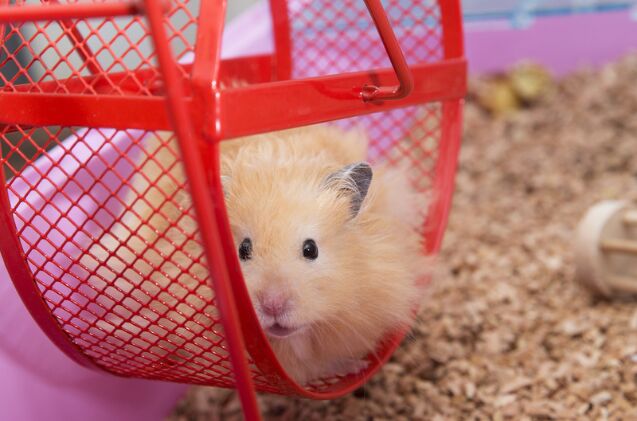Can I Teach My Hamster to be Quiet at Night?

Have you ever scrolled social media to find viral videos of hamsters running enthusiastically on their exercise wheel? There is no denying that it’s an adorable sight! Unfortunately, it becomes far less cute for hamster parents when their nighttime playtime keeps us awake all night.
If you’re wondering if there’s a way to train your hamster to adjust to a more human sleep cycle, you’re not alone.
In this post, I will share some key information about hamsters and their sleep habits, including why your hamster is so active when the sun goes down. Plus, I’ll share tips and tricks to create a happy home for both you and your hamster – including gear that has helped me coexist peacefully with my hamsters over the years.
With a few minor changes or updates, you can share your life with a hamster and enjoy a good night’s sleep. I promise!
Why is My Hamster So Active at Night?
Since bringing your hamster home, you may have noticed that they are most active at night, catching up on their sleep throughout the day. If you’ve been searching for answers (which you probably are, if you’re reading this), you may have seen many people explaining that you’re experiencing this schedule because hamsters are nocturnal – meaning they are active at night and sleep during the day. However, this isn’t entirely accurate.
Hamsters are actually crepuscular. This means that (according to Cambridge Dictionary), they are “active or appearing at the time of day just before the sun goes down, or just after the sun rises, when the light is not bright.”
With pet hamsters, this is often mistaken as nocturnal because we are asleep during that period between dusk and dawn. Therefore, we don’t experience them slowing down or resting during the middle of the night.
Returning to the original question: “Why is my hamster so active at night?” The short answer is this behavior is the result of their biological wiring. In the wild, they are active when it is safer to emerge and seek out food. This allows them to hide when predators are more likely to see them in the daylight hours.
Are All Hamsters Active at Night?
As with any behavior, there are always going to be exceptions. If you were to interview 100 hamster parents, you are likely going to find one or two that “break the rules” and are active during the day. However, this is rare. It’s safe to assume that any hamster you adopt and bring home will be most active at dusk and dawn, not during the daylight hours.
Can You Change a Hamster’s Sleep Schedule?
It is possible to change a pet’s sleep cycle. However, there is no guaranteed approach that will work with every hamster. It’s also not recommended by experts as this process could cause significant stress and anxiety to your hamster by forcing them to go against their instincts.
Rather than changing your new pet’s sleep schedule, it’s recommended that you instead focus on making changes to their habitat to accommodate their natural sleep pattern.
Does this mean your hamster will always be active at night? Not necessarily. Over time, you may see your hamster adjusting their sleep schedule to better align with your schedule without trying to make a change yourself. But it should not be forced on them.
Influencing Your Hamster’s Sleep Schedule
While it’s not recommended that you train your hamster to completely change their sleep schedule, you can take steps to influence it and encourage them to adjust slightly to your routine.
The best approach to influencing your hamster’s sleep schedule is to encourage them to stay awake and play when they are already awake, not waking them up if they have fallen asleep. Hamsters are startled easily due to their poor eyesight, which means waking them up could trigger severe anxiety.
If your hamster is awake at a time that suits your schedule and routine, take the opportunity to spend quality time together while encouraging them to stay awake longer. This could mean playing with them or giving them lots of affection if they are tame and like to be handled.
This should be done gradually, keeping them awake just a little longer each day. As you encourage these changes, watch carefully for any signs of stress and anxiety, such as:
- Loss of appetite
- Refusing to drink water
- Increased vocalization
- Hiding constantly, especially during hours when they are usually active
- Lethargy or loss of energy
- Failing to chew and wear down their teeth, overgrown teeth
- Chewing at the cage bars
- Hair loss, bald spots, overgrooming
- Obsessive behaviors like digging, scratching, or licking
- Uncharacteristic aggression
If you notice any of these signs, take a step back. This could indicate that you’re pushing your hamster to make changes too quickly or that they aren’t comfortable changing their sleep schedule at all.
Reevaluate your efforts and make a decision that prioritizes their quality of life. If that means abandoning this attempt and focusing instead on changing their habitat to minimize noise, that may be the best solution for everyone.
How to Get Your Hamster to Be Quiet at Night
As I mentioned, the best approach to addressing the problem of your hamster keeping you awake at night is to adjust their habitat to reduce noise while allowing them to go about their day (or night). There are some elements of their habitat that could be increasing noise levels, such as a squeaky exercise wheel or rattling cage. Here are a few simple changes you can make to cut down on the noises and help yourself sleep at night:
Ensure the Cage is Large Enough
Does your hamster keep you up chewing on their cage bars at night? If so, it could be a red flag that their habitat doesn’t provide everything they need to thrive. Many of the popular hamster cages on sale in big box stores are actually too small, creating stress and anxiety. Ensuring your hamster’s cage is large enough can help lower stress levels and potentially curb this bad behavior.
For a standard hamster, the ideal habitat should be at least 24” by 12” of floor space. While you can add tunnels, platforms, and other elements to extend their space vertically, the minimum floor space should still be considered. If you have a dwarf hamster, the requirements are obviously smaller.
Consider A New Place for Your Hamster’s Cage
Another important consideration is the placement of your hamster’s habitat. We often see parents choosing hamsters as pets for children, setting up a cage in their bedroom where they can be close to them and watch them all the time. Not only is this not the ideal arrangement for the hamster (children are loud and unpredictable, causing hamsters to be stressed), but it also means any noises your hamster makes at night will be in their bedroom, keeping them awake at all hours.
Try moving the hamster to another room, like an office or spare room. This allows you to close the door at night, keeping your hamster’s noise safely contained and creating a quiet sleep environment for everyone else in the house.
If you don’t have a spare room, you can also look at common areas of the home, but try to avoid placing them in loud, high-traffic areas or too close to items like televisions that will keep them awake while trying to sleep during the day. One option could be a quieter corner of the living room with a blanket carefully placed over the cage to reduce light and noise. But be sure that there is enough airflow and ventilation when the blanket is in place.
Place a Mat Under Their Cage
One cause of noise from a hamster cage is the vibrations of the cage bottom against the surface it is resting on. Luckily, this problem is easily addressed. Placing a mat under the cage can help soften any movement, eliminating the sound it would otherwise create. As a bonus, choose a mat that is easily wiped off, making clean-up easier for you moving forward. It may even serve to protect your furniture from unnecessary damage.
Choose a Quieter Hamster Wheel
Your hamster’s wheel is vital to their health and well-being, providing a safe outlet for their energy. Unfortunately, the wheel is the most common culprit of noise from a hamster cage. From wheels that rattle in their stands to those that make loud squeaking noises as the wheel turns, they can definitely keep you up at night.
If your hamster’s wheel is metal and making a squeaking noise, you may simply need to oil it up. Both coconut and vegetable oil are hamster-safe and can help stop the squeaking.
One of the most common causes of noise for plastic wheels is a rough edge of the plastic scraping against the wheel's stand as it spins. Carefully inspect your hamster’s wheel, looking for rough spots where this may be the case. Using fine sandpaper, smooth out the surface to allow it to spin more freely.
Some wheels simply can’t be silenced. If you have tried these approaches and the sound of your hamster’s wheel is still too much, it may be time to invest in a new wheel. The Kaytee Silent Spinner Wheel is a popular choice designed to allow hamsters to exercise with little to no noise. It is available in 4 sizes, ranging from 6.5” to 12”, allowing it to accommodate all hamster species.
Try to Find a Quieter Hamster Bottle
Water bottles are another common item in a hamster cage that often makes noise. Traditional water bottles feature a small metal ball inside the metal pipe from which the hamster drinks. As the hamster drinks, this creates a clicking noise from metal on metal.
Noise can also sometimes result from the bottle rattling against the side of the cage. This can be reduced by using a water bottle held by a secure plastic clip instead of the usual metal wire hooks, like the MidWest Homes for Pets Small Animal Water Bottle. Alternatively, you can try placing padding between the bottle and the cage wall, but be careful not to use anything that can’t be chewed on, as hamsters are known to be chewers.
Hamsters can also drink out of water bowls, like dogs or cats. However, a bowl placed on the ground in the cage is likely to be knocked over or filled with shavings during their burrowing activities. A better option is to get a water bowl that can be secured to the side of the cage slightly off the ground, like the Septillar Hanging Water Dispenser.
Offer Quiet Toys and Activities
Another possible cause of nighttime noise is boredom. If your hamster isn’t given opportunities for the mental and physical stimulation they need, they may resort to other noisy behaviors, like chewing on their cage bars or items within the cage, like food dishes. One way to prevent this is to provide quiet toys or chews to keep them entertained throughout the night.
There are several options that will meet this need. Some examples I recommend include:
- Treat-style chews like the Kaytee Combo Chew Apple Wood & Puzzle
- Chew-focused toys for both chewing and playtime, like the Kaytee Knot Nibbler Chew Toy
- Hideaways that double as a safe chew treat like the Kaytee Premium Timothy Treat Hideout
Try offering one or two chew solutions and watch to see what they are attracted to. Finding the right option for your pet will involve a bit of trial and error. However, when you find something your hamster loves, everyone will be happier for it!
Final Thoughts: Keeping Your Hamster Quiet at Night
While it is not recommended to try to change your hamster’s sleep schedule, there are steps you can take to set both you and your pint-sized furry friend up for success.
By setting up their habitat intentionally and investing in products designed to be quiet during use, you can minimize the noise that they make during their active hours. You can take this a step further by placing their cage or tank in a location where any sound may be muffled.
Trying to change your hamster’s natural instincts will only create stress and anxiety. Instead, focus on accommodating these behaviours and creating a happy house for everyone involved.
Join the PetGuide community. Get the latest pet news and product recommendations by subscribing to our newsletter here.

Britt Kascjak is a proud pet mom, sharing her heart (and her home) with her “pack” which includes her husband John, their 2 dogs – Lucifer and Willow – and their 2 cats – Pippen and Jinx. She has been active in the animal rescue community for over 15 years, volunteering, fostering and advocating for organizations across Canada and the US. In her free time, she enjoys traveling around the country camping, hiking, and canoeing with her pets.
More by Britt
























